SCI260 Biochemistry: Exploring Glycolysis, Gluconeogenesis and PPP
VerifiedAdded on 2023/06/10
|6
|1123
|414
Homework Assignment
AI Summary
This assignment provides detailed answers to questions related to glycolysis, gluconeogenesis, and the pentose phosphate pathway (PPP), crucial for understanding glucose metabolism. It identifies shared enzyme-catalyzed reactions between glycolysis and gluconeogenesis, explains the necessity of unique enzymes in gluconeogenesis, and clarifies the role of specific reactions like the conversion of oxaloacetate into phosphoenolpyruvate. Furthermore, it discusses the impact of glucagon levels on glycogen degradation, the organs involved in gluconeogenesis during fasting, and the tissue-specific presence of glucose 6 phosphatase. The assignment also highlights the products and significance of the pentose phosphate pathway, comparing NADH and NADPH molecules and their distinct functions in biological processes.

Running head: BIOCHEMISTRY
BIOCHEMISTRY
Name of the student:
Name of the University:
Author note:
BIOCHEMISTRY
Name of the student:
Name of the University:
Author note:
Paraphrase This Document
Need a fresh take? Get an instant paraphrase of this document with our AI Paraphraser
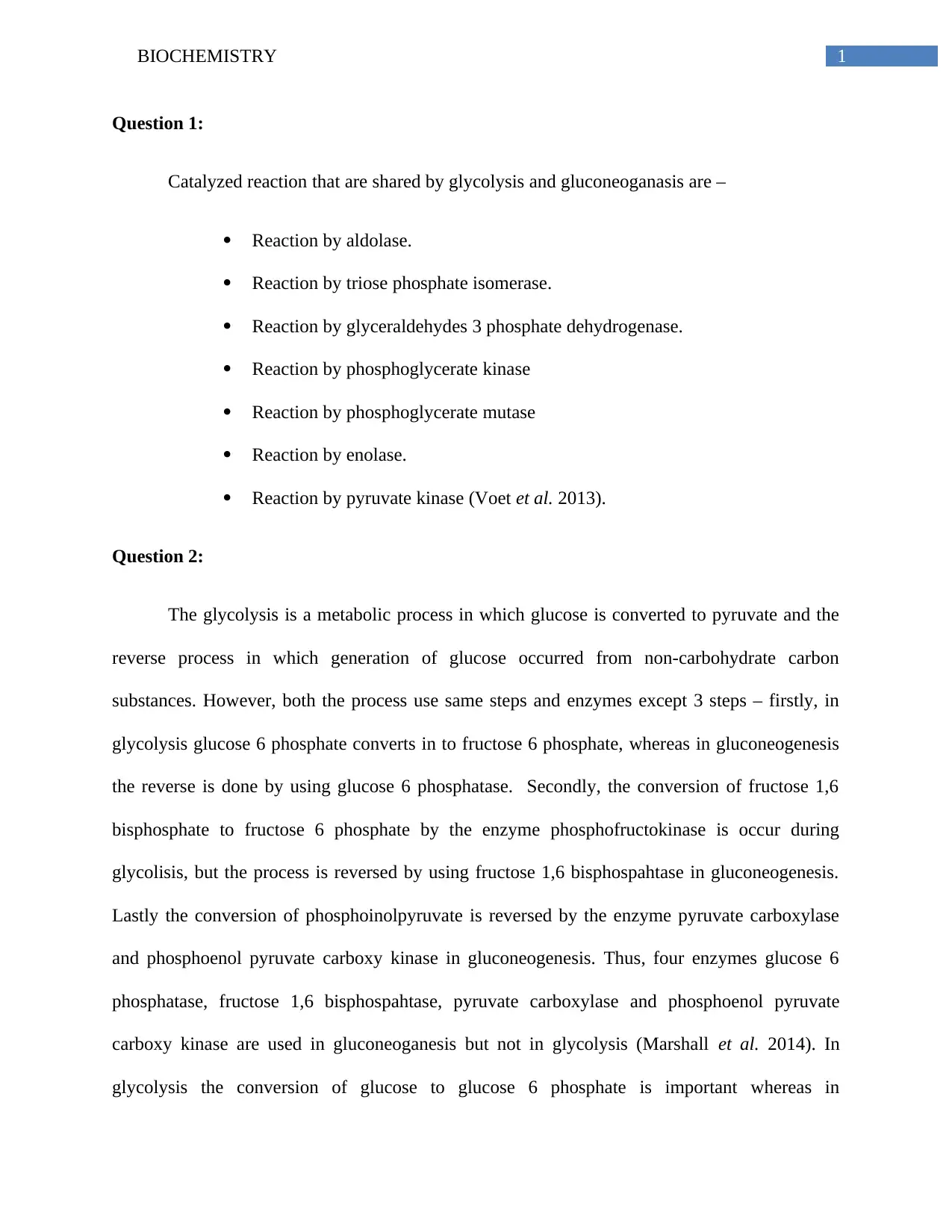
1BIOCHEMISTRY
Question 1:
Catalyzed reaction that are shared by glycolysis and gluconeoganasis are –
Reaction by aldolase.
Reaction by triose phosphate isomerase.
Reaction by glyceraldehydes 3 phosphate dehydrogenase.
Reaction by phosphoglycerate kinase
Reaction by phosphoglycerate mutase
Reaction by enolase.
Reaction by pyruvate kinase (Voet et al. 2013).
Question 2:
The glycolysis is a metabolic process in which glucose is converted to pyruvate and the
reverse process in which generation of glucose occurred from non-carbohydrate carbon
substances. However, both the process use same steps and enzymes except 3 steps – firstly, in
glycolysis glucose 6 phosphate converts in to fructose 6 phosphate, whereas in gluconeogenesis
the reverse is done by using glucose 6 phosphatase. Secondly, the conversion of fructose 1,6
bisphosphate to fructose 6 phosphate by the enzyme phosphofructokinase is occur during
glycolisis, but the process is reversed by using fructose 1,6 bisphospahtase in gluconeogenesis.
Lastly the conversion of phosphoinolpyruvate is reversed by the enzyme pyruvate carboxylase
and phosphoenol pyruvate carboxy kinase in gluconeogenesis. Thus, four enzymes glucose 6
phosphatase, fructose 1,6 bisphospahtase, pyruvate carboxylase and phosphoenol pyruvate
carboxy kinase are used in gluconeoganesis but not in glycolysis (Marshall et al. 2014). In
glycolysis the conversion of glucose to glucose 6 phosphate is important whereas in
Question 1:
Catalyzed reaction that are shared by glycolysis and gluconeoganasis are –
Reaction by aldolase.
Reaction by triose phosphate isomerase.
Reaction by glyceraldehydes 3 phosphate dehydrogenase.
Reaction by phosphoglycerate kinase
Reaction by phosphoglycerate mutase
Reaction by enolase.
Reaction by pyruvate kinase (Voet et al. 2013).
Question 2:
The glycolysis is a metabolic process in which glucose is converted to pyruvate and the
reverse process in which generation of glucose occurred from non-carbohydrate carbon
substances. However, both the process use same steps and enzymes except 3 steps – firstly, in
glycolysis glucose 6 phosphate converts in to fructose 6 phosphate, whereas in gluconeogenesis
the reverse is done by using glucose 6 phosphatase. Secondly, the conversion of fructose 1,6
bisphosphate to fructose 6 phosphate by the enzyme phosphofructokinase is occur during
glycolisis, but the process is reversed by using fructose 1,6 bisphospahtase in gluconeogenesis.
Lastly the conversion of phosphoinolpyruvate is reversed by the enzyme pyruvate carboxylase
and phosphoenol pyruvate carboxy kinase in gluconeogenesis. Thus, four enzymes glucose 6
phosphatase, fructose 1,6 bisphospahtase, pyruvate carboxylase and phosphoenol pyruvate
carboxy kinase are used in gluconeoganesis but not in glycolysis (Marshall et al. 2014). In
glycolysis the conversion of glucose to glucose 6 phosphate is important whereas in
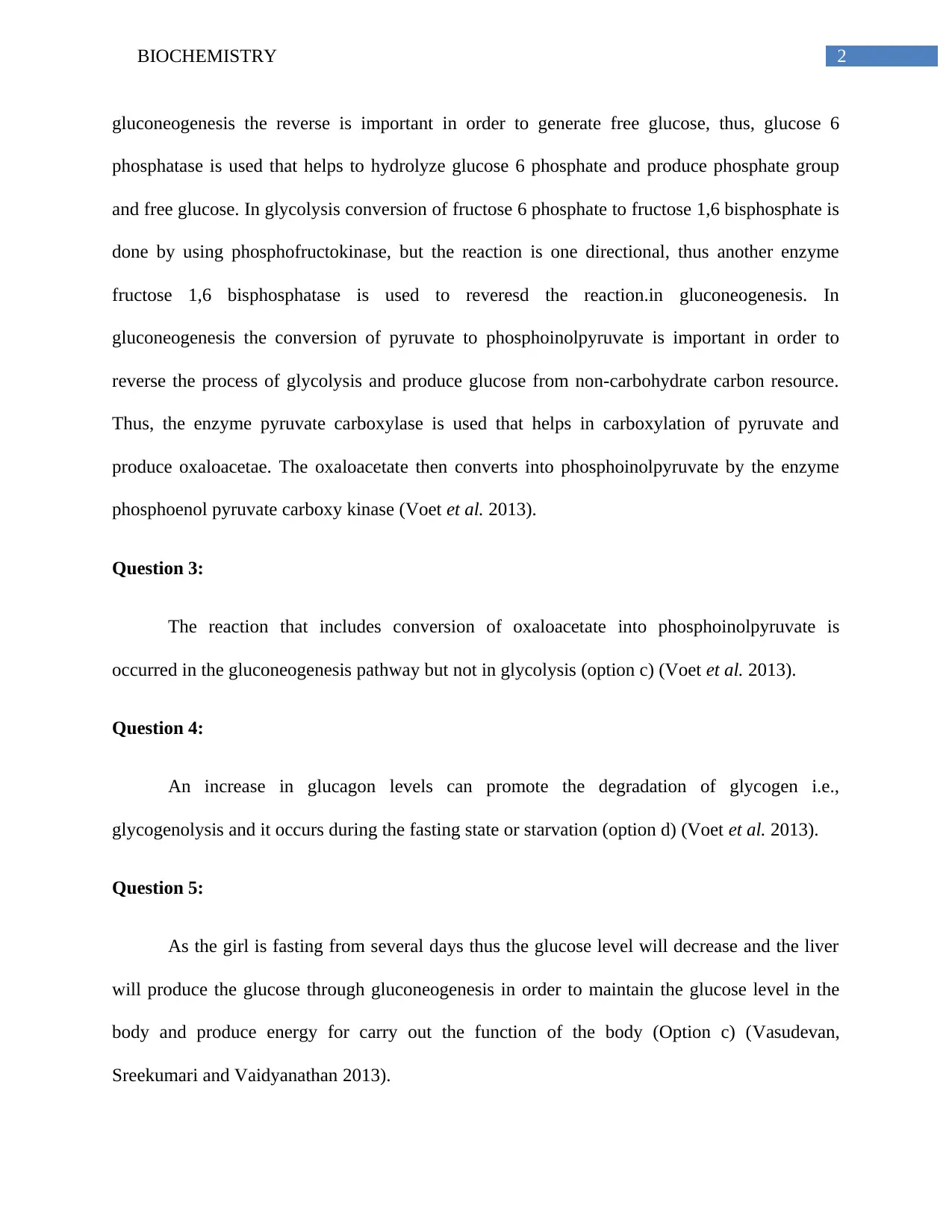
2BIOCHEMISTRY
gluconeogenesis the reverse is important in order to generate free glucose, thus, glucose 6
phosphatase is used that helps to hydrolyze glucose 6 phosphate and produce phosphate group
and free glucose. In glycolysis conversion of fructose 6 phosphate to fructose 1,6 bisphosphate is
done by using phosphofructokinase, but the reaction is one directional, thus another enzyme
fructose 1,6 bisphosphatase is used to reveresd the reaction.in gluconeogenesis. In
gluconeogenesis the conversion of pyruvate to phosphoinolpyruvate is important in order to
reverse the process of glycolysis and produce glucose from non-carbohydrate carbon resource.
Thus, the enzyme pyruvate carboxylase is used that helps in carboxylation of pyruvate and
produce oxaloacetae. The oxaloacetate then converts into phosphoinolpyruvate by the enzyme
phosphoenol pyruvate carboxy kinase (Voet et al. 2013).
Question 3:
The reaction that includes conversion of oxaloacetate into phosphoinolpyruvate is
occurred in the gluconeogenesis pathway but not in glycolysis (option c) (Voet et al. 2013).
Question 4:
An increase in glucagon levels can promote the degradation of glycogen i.e.,
glycogenolysis and it occurs during the fasting state or starvation (option d) (Voet et al. 2013).
Question 5:
As the girl is fasting from several days thus the glucose level will decrease and the liver
will produce the glucose through gluconeogenesis in order to maintain the glucose level in the
body and produce energy for carry out the function of the body (Option c) (Vasudevan,
Sreekumari and Vaidyanathan 2013).
gluconeogenesis the reverse is important in order to generate free glucose, thus, glucose 6
phosphatase is used that helps to hydrolyze glucose 6 phosphate and produce phosphate group
and free glucose. In glycolysis conversion of fructose 6 phosphate to fructose 1,6 bisphosphate is
done by using phosphofructokinase, but the reaction is one directional, thus another enzyme
fructose 1,6 bisphosphatase is used to reveresd the reaction.in gluconeogenesis. In
gluconeogenesis the conversion of pyruvate to phosphoinolpyruvate is important in order to
reverse the process of glycolysis and produce glucose from non-carbohydrate carbon resource.
Thus, the enzyme pyruvate carboxylase is used that helps in carboxylation of pyruvate and
produce oxaloacetae. The oxaloacetate then converts into phosphoinolpyruvate by the enzyme
phosphoenol pyruvate carboxy kinase (Voet et al. 2013).
Question 3:
The reaction that includes conversion of oxaloacetate into phosphoinolpyruvate is
occurred in the gluconeogenesis pathway but not in glycolysis (option c) (Voet et al. 2013).
Question 4:
An increase in glucagon levels can promote the degradation of glycogen i.e.,
glycogenolysis and it occurs during the fasting state or starvation (option d) (Voet et al. 2013).
Question 5:
As the girl is fasting from several days thus the glucose level will decrease and the liver
will produce the glucose through gluconeogenesis in order to maintain the glucose level in the
body and produce energy for carry out the function of the body (Option c) (Vasudevan,
Sreekumari and Vaidyanathan 2013).
⊘ This is a preview!⊘
Do you want full access?
Subscribe today to unlock all pages.

Trusted by 1+ million students worldwide
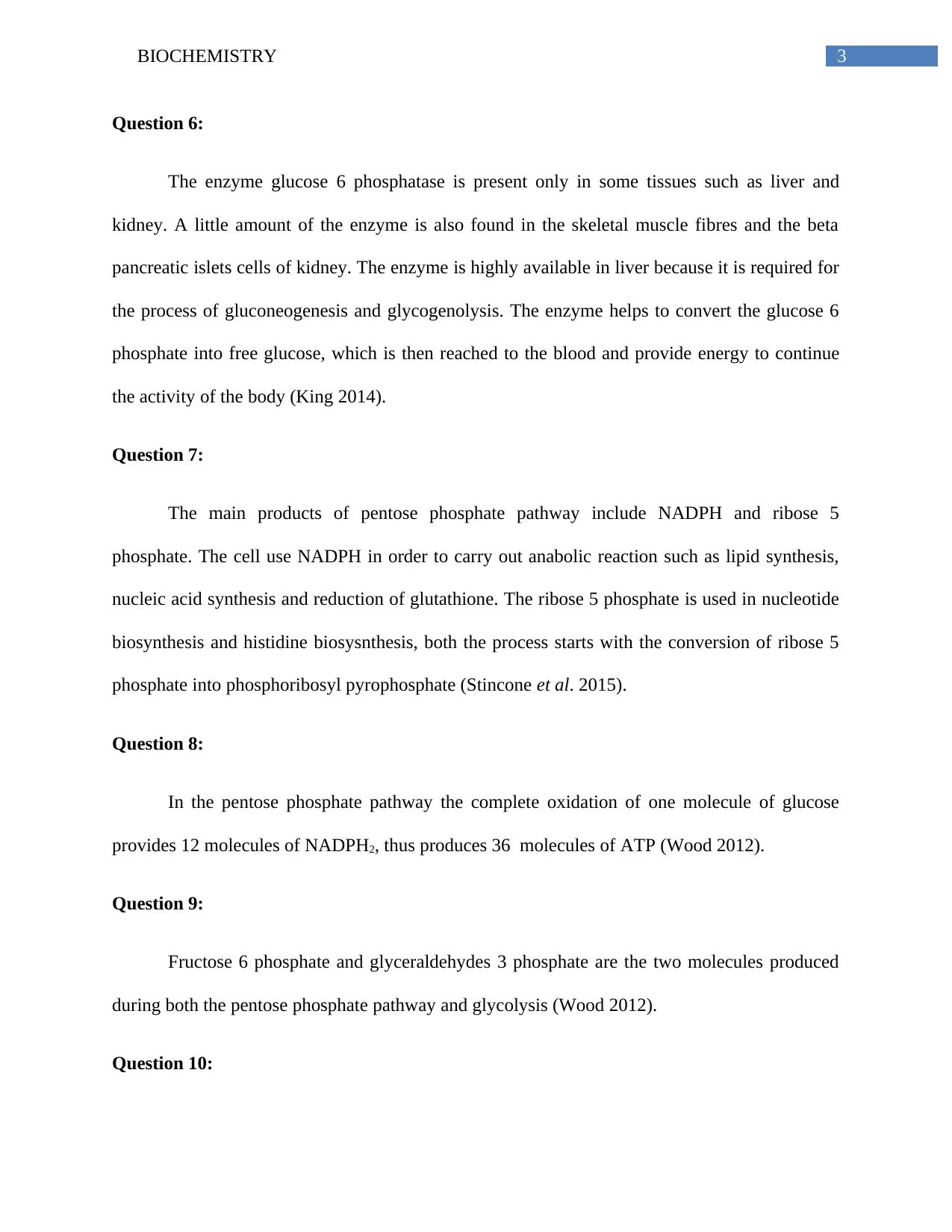
3BIOCHEMISTRY
Question 6:
The enzyme glucose 6 phosphatase is present only in some tissues such as liver and
kidney. A little amount of the enzyme is also found in the skeletal muscle fibres and the beta
pancreatic islets cells of kidney. The enzyme is highly available in liver because it is required for
the process of gluconeogenesis and glycogenolysis. The enzyme helps to convert the glucose 6
phosphate into free glucose, which is then reached to the blood and provide energy to continue
the activity of the body (King 2014).
Question 7:
The main products of pentose phosphate pathway include NADPH and ribose 5
phosphate. The cell use NADPH in order to carry out anabolic reaction such as lipid synthesis,
nucleic acid synthesis and reduction of glutathione. The ribose 5 phosphate is used in nucleotide
biosynthesis and histidine biosysnthesis, both the process starts with the conversion of ribose 5
phosphate into phosphoribosyl pyrophosphate (Stincone et al. 2015).
Question 8:
In the pentose phosphate pathway the complete oxidation of one molecule of glucose
provides 12 molecules of NADPH2, thus produces 36 molecules of ATP (Wood 2012).
Question 9:
Fructose 6 phosphate and glyceraldehydes 3 phosphate are the two molecules produced
during both the pentose phosphate pathway and glycolysis (Wood 2012).
Question 10:
Question 6:
The enzyme glucose 6 phosphatase is present only in some tissues such as liver and
kidney. A little amount of the enzyme is also found in the skeletal muscle fibres and the beta
pancreatic islets cells of kidney. The enzyme is highly available in liver because it is required for
the process of gluconeogenesis and glycogenolysis. The enzyme helps to convert the glucose 6
phosphate into free glucose, which is then reached to the blood and provide energy to continue
the activity of the body (King 2014).
Question 7:
The main products of pentose phosphate pathway include NADPH and ribose 5
phosphate. The cell use NADPH in order to carry out anabolic reaction such as lipid synthesis,
nucleic acid synthesis and reduction of glutathione. The ribose 5 phosphate is used in nucleotide
biosynthesis and histidine biosysnthesis, both the process starts with the conversion of ribose 5
phosphate into phosphoribosyl pyrophosphate (Stincone et al. 2015).
Question 8:
In the pentose phosphate pathway the complete oxidation of one molecule of glucose
provides 12 molecules of NADPH2, thus produces 36 molecules of ATP (Wood 2012).
Question 9:
Fructose 6 phosphate and glyceraldehydes 3 phosphate are the two molecules produced
during both the pentose phosphate pathway and glycolysis (Wood 2012).
Question 10:
Paraphrase This Document
Need a fresh take? Get an instant paraphrase of this document with our AI Paraphraser
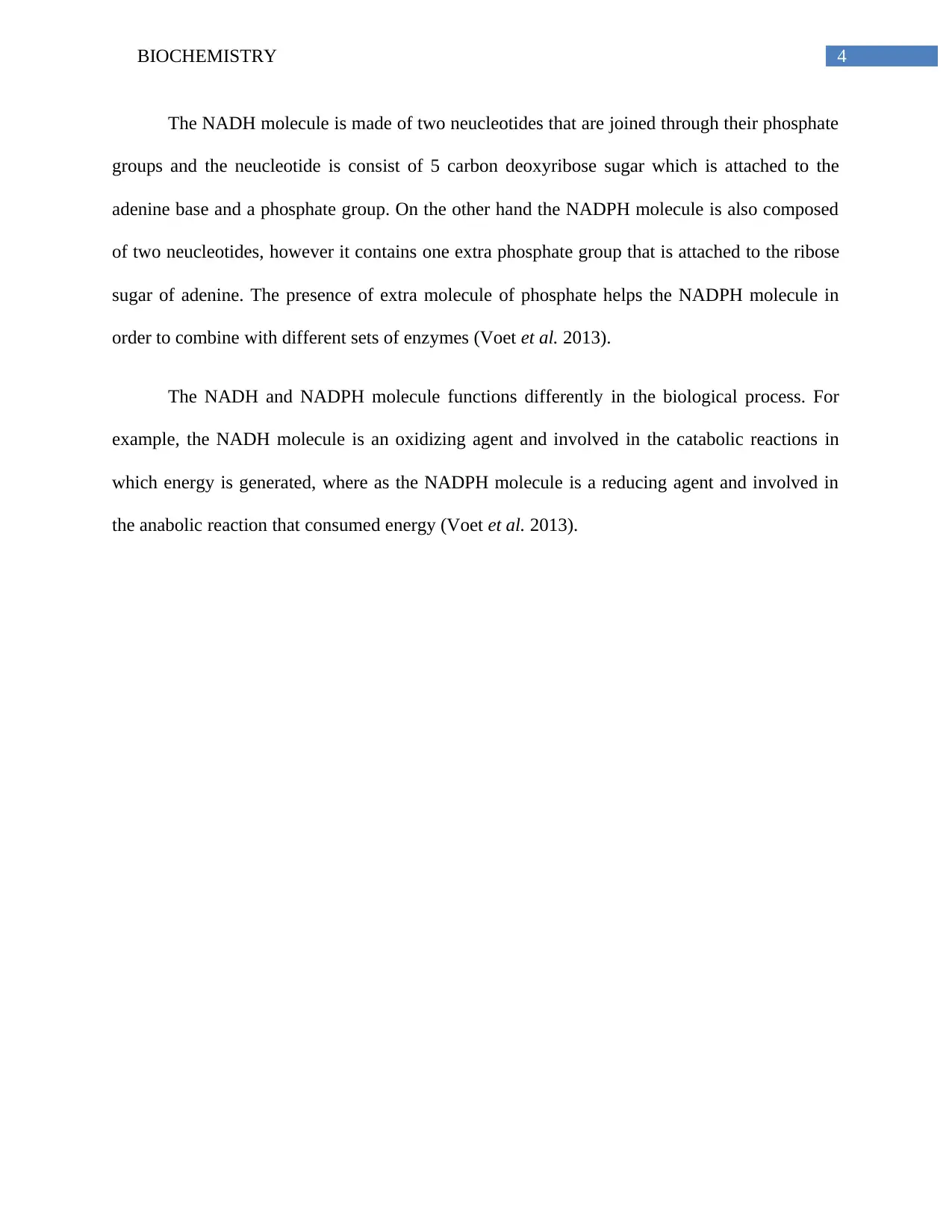
4BIOCHEMISTRY
The NADH molecule is made of two neucleotides that are joined through their phosphate
groups and the neucleotide is consist of 5 carbon deoxyribose sugar which is attached to the
adenine base and a phosphate group. On the other hand the NADPH molecule is also composed
of two neucleotides, however it contains one extra phosphate group that is attached to the ribose
sugar of adenine. The presence of extra molecule of phosphate helps the NADPH molecule in
order to combine with different sets of enzymes (Voet et al. 2013).
The NADH and NADPH molecule functions differently in the biological process. For
example, the NADH molecule is an oxidizing agent and involved in the catabolic reactions in
which energy is generated, where as the NADPH molecule is a reducing agent and involved in
the anabolic reaction that consumed energy (Voet et al. 2013).
The NADH molecule is made of two neucleotides that are joined through their phosphate
groups and the neucleotide is consist of 5 carbon deoxyribose sugar which is attached to the
adenine base and a phosphate group. On the other hand the NADPH molecule is also composed
of two neucleotides, however it contains one extra phosphate group that is attached to the ribose
sugar of adenine. The presence of extra molecule of phosphate helps the NADPH molecule in
order to combine with different sets of enzymes (Voet et al. 2013).
The NADH and NADPH molecule functions differently in the biological process. For
example, the NADH molecule is an oxidizing agent and involved in the catabolic reactions in
which energy is generated, where as the NADPH molecule is a reducing agent and involved in
the anabolic reaction that consumed energy (Voet et al. 2013).
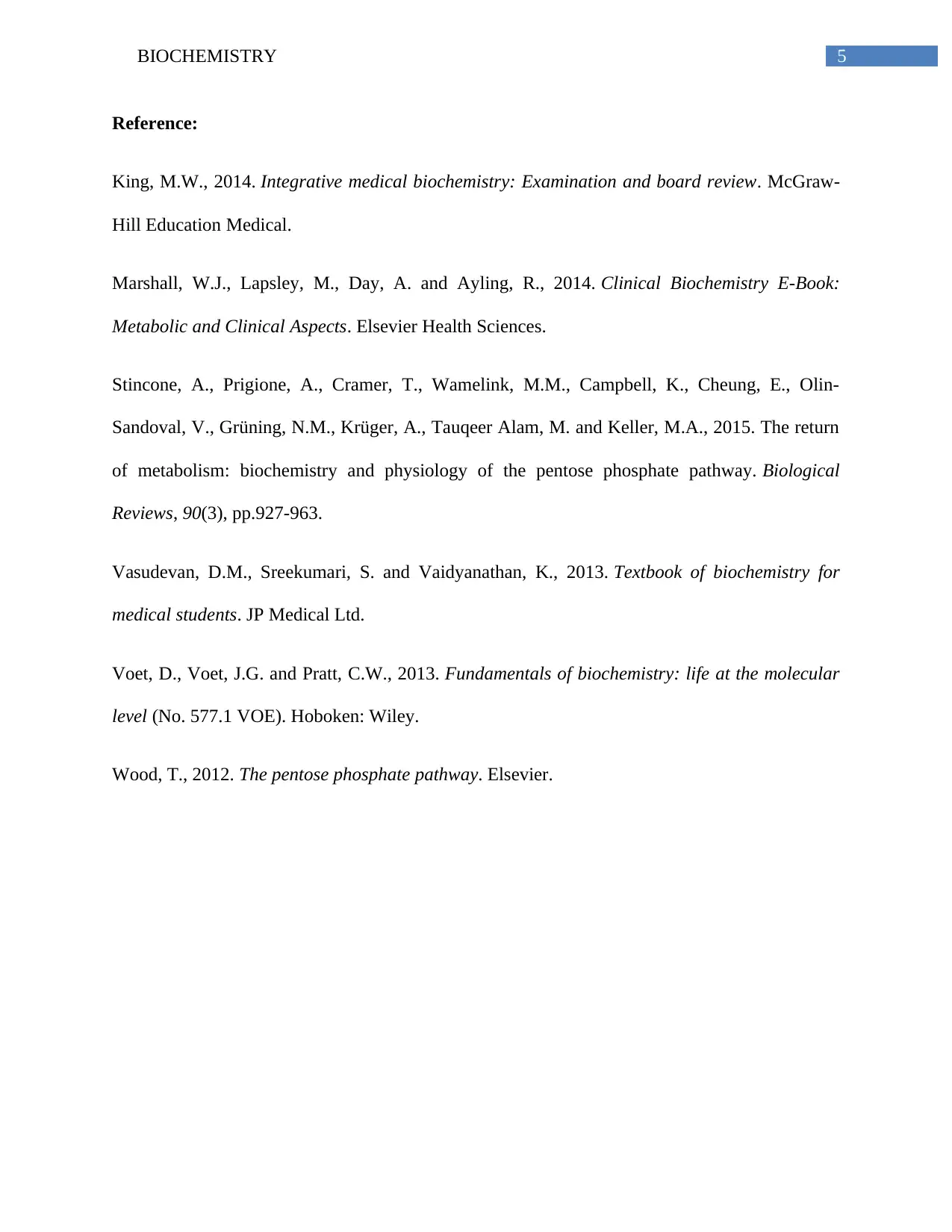
5BIOCHEMISTRY
Reference:
King, M.W., 2014. Integrative medical biochemistry: Examination and board review. McGraw-
Hill Education Medical.
Marshall, W.J., Lapsley, M., Day, A. and Ayling, R., 2014. Clinical Biochemistry E-Book:
Metabolic and Clinical Aspects. Elsevier Health Sciences.
Stincone, A., Prigione, A., Cramer, T., Wamelink, M.M., Campbell, K., Cheung, E., Olin‐
Sandoval, V., Grüning, N.M., Krüger, A., Tauqeer Alam, M. and Keller, M.A., 2015. The return
of metabolism: biochemistry and physiology of the pentose phosphate pathway. Biological
Reviews, 90(3), pp.927-963.
Vasudevan, D.M., Sreekumari, S. and Vaidyanathan, K., 2013. Textbook of biochemistry for
medical students. JP Medical Ltd.
Voet, D., Voet, J.G. and Pratt, C.W., 2013. Fundamentals of biochemistry: life at the molecular
level (No. 577.1 VOE). Hoboken: Wiley.
Wood, T., 2012. The pentose phosphate pathway. Elsevier.
Reference:
King, M.W., 2014. Integrative medical biochemistry: Examination and board review. McGraw-
Hill Education Medical.
Marshall, W.J., Lapsley, M., Day, A. and Ayling, R., 2014. Clinical Biochemistry E-Book:
Metabolic and Clinical Aspects. Elsevier Health Sciences.
Stincone, A., Prigione, A., Cramer, T., Wamelink, M.M., Campbell, K., Cheung, E., Olin‐
Sandoval, V., Grüning, N.M., Krüger, A., Tauqeer Alam, M. and Keller, M.A., 2015. The return
of metabolism: biochemistry and physiology of the pentose phosphate pathway. Biological
Reviews, 90(3), pp.927-963.
Vasudevan, D.M., Sreekumari, S. and Vaidyanathan, K., 2013. Textbook of biochemistry for
medical students. JP Medical Ltd.
Voet, D., Voet, J.G. and Pratt, C.W., 2013. Fundamentals of biochemistry: life at the molecular
level (No. 577.1 VOE). Hoboken: Wiley.
Wood, T., 2012. The pentose phosphate pathway. Elsevier.
⊘ This is a preview!⊘
Do you want full access?
Subscribe today to unlock all pages.

Trusted by 1+ million students worldwide
1 out of 6